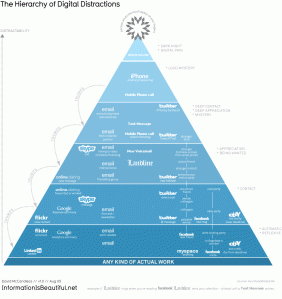
Image: melodi2
You know the old adage show me your friends and I’ll show you who you are?
Well, according to the Pew Research Center’s Internet and American Life Project ICT users can be divided into 10 different groups or “tribes” according to your assets (the gadgets you have), actions (how you use ICTs) and attitudes (how you feel about the role of ICTs in your lives).
According to the report the 10 groups or tribes can be divided into two broad categories:
1. Motivated by Mobility: Five groups in this typology – making up 39% of the
adult population – have seen the frequency of their online use grow as their reliance on mobile devices has increased.
2. Stationary media will do: The remaining 61% of the adult population does not feel the pull of mobility – or anything else – drawing them further into the digital world.
The Motivated by Mobility Group is made up of:
 Digital collaborators (8 per cent of the population) are very much about continual information exchange with others, as they frequently mix it up with online collaborators to create and share content or express themselves
Digital collaborators (8 per cent of the population) are very much about continual information exchange with others, as they frequently mix it up with online collaborators to create and share content or express themselves
 Ambivalent networkers (7 per cent) are extremely active in using social networking sites and accessing digital resources “on the go” yet are not always thrilled to be contacted by others. They sometimes yearn for a break from online use and pervasive connectivity
Ambivalent networkers (7 per cent) are extremely active in using social networking sites and accessing digital resources “on the go” yet are not always thrilled to be contacted by others. They sometimes yearn for a break from online use and pervasive connectivity
 Media movers (7 per cent) are the accelerants of user-generated content as they use their ICT assets to send material (say, a photo or video they have taken) out onto the Web.
Media movers (7 per cent) are the accelerants of user-generated content as they use their ICT assets to send material (say, a photo or video they have taken) out onto the Web.
 Roving nodes (9 per cent) are active managers of their social lives using basic applications – texting and e-mailing – to connect with others, pass along information, and bolster personal productivity.
Roving nodes (9 per cent) are active managers of their social lives using basic applications – texting and e-mailing – to connect with others, pass along information, and bolster personal productivity.
 Mobile newbies (8 per cent) are occasional Internet users, but many in this group are recent cell phone adopters and very enthusiastic about how mobile service makes them more available to others. They would be hard pressed to give up their cell phones. http://www.sxc.hu/photo/441340
Mobile newbies (8 per cent) are occasional Internet users, but many in this group are recent cell phone adopters and very enthusiastic about how mobile service makes them more available to others. They would be hard pressed to give up their cell phones. http://www.sxc.hu/photo/441340
The Stationary media will do group is made up of:
 Desktop veterans (13 per cent) are tech-oriented, but in a “year 2004” kind of way. They consume online information and connect with others using traditional tools such as e-mail on a home high-speed connection. They are not heavy users of cell phones for much beyond a voice call.
Desktop veterans (13 per cent) are tech-oriented, but in a “year 2004” kind of way. They consume online information and connect with others using traditional tools such as e-mail on a home high-speed connection. They are not heavy users of cell phones for much beyond a voice call.
 Drifting surfers (14 per cent) have the tools for connectivity, but are relatively infrequent users of them. They say they could give up their Internet and cell phones. In spite of years of online experience, they seem to have checked out of the digital revolution.
Drifting surfers (14 per cent) have the tools for connectivity, but are relatively infrequent users of them. They say they could give up their Internet and cell phones. In spite of years of online experience, they seem to have checked out of the digital revolution.
 Information encumbered (10 per cent) have average amounts of connectivity, but suffer from information overload and have a tough time getting their gadgets to work without help from others.
Information encumbered (10 per cent) have average amounts of connectivity, but suffer from information overload and have a tough time getting their gadgets to work without help from others.
 Tech indifferent (10 per cent) have limited online capability at home and, even though most have cell phones, they bristle at the intrusiveness cell phones can foster.
Tech indifferent (10 per cent) have limited online capability at home and, even though most have cell phones, they bristle at the intrusiveness cell phones can foster.
 Off the network (14 per cent) lack the tools for digital connectivity, as they have neither online access nor cell phones.
Off the network (14 per cent) lack the tools for digital connectivity, as they have neither online access nor cell phones.
They also have a test you can do to quickly find out which tribe you belong to.
I’m a Digital Collaborator 🙂 and here’s what they say about me:
If you are a Digital Collaborator, you use information technology to work with and share your creations with others. You are enthusiastic about how ICTs help you connect with others and confident in your ability to manage digital devices and information. For you, the digital commons can be a camp, a lab, or a theater group – places to gather with others to develop something new.
Seems they know me pretty well 🙂
Thanks to EmeraldInsight for the heads up on the report!
Click on the images for the copyright holders.
![]()







 Tracking
Tracking 
 Summary of Findings
Summary of Findings




 Mobile newbies (8 per cent) are occasional Internet users, but many in this group are recent cell phone adopters and very enthusiastic about how mobile service makes them more available to others. They would be hard pressed to give up their cell phones.
Mobile newbies (8 per cent) are occasional Internet users, but many in this group are recent cell phone adopters and very enthusiastic about how mobile service makes them more available to others. They would be hard pressed to give up their cell phones. 



